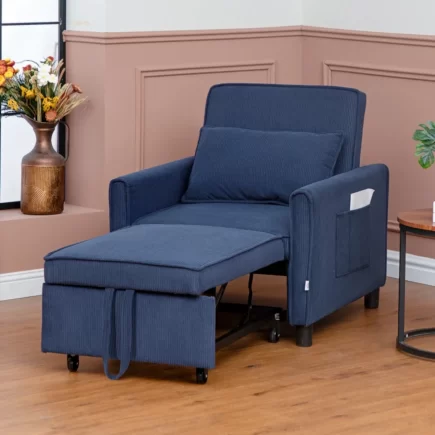Sitting on a sofa seems like a simple task, but did you know that your posture can impact your health? Poor posture can lead to a range of issues, from back pain to muscle strain and even long-term spinal problems. Maintaining good posture while sitting on a sofa is important for both comfort and your health.

In this article, we’ll go over the best ways to sit correctly, so you can enjoy your relaxation time without worrying about your spine.
1. Choose the Right Sofa
The foundation of good posture starts with choosing the right sofa.
- Firmness and Back Support: Opt for a sofa that offers sufficient firmness and support for your back. A too-soft sofa will encourage slouching, while a very firm one might be uncomfortable. Ensure the seat depth and height are such that you can sit upright without difficulty.
- Proper Seat Depth: Your feet should be flat on the ground, and your knees should form a 90-degree angle. The sofa should allow you to sit all the way back, ensuring your back is supported.
If you find a sofa too deep or shallow, consider adding cushions for additional support.
2. Sit Back Fully for Support

When you sit on the sofa, position yourself all the way back so your spine is supported by the backrest. This keeps your lower back, shoulders, and neck in contact with the sofa, reducing slouching and tension.
Align & Maintain Neutral Spine
Maintain your spine’s natural curves. Avoid rounding forward or arching excessively. If the sofa lacks lumbar support, place a cushion behind your lower back. Keep your shoulders relaxed and use pillows to support your neck if needed for long-term comfort.
3. Keep Your Feet Flat on the Ground
Your legs play an important role in maintaining proper posture.
- Proper Leg Positioning: Ensure that your feet are flat on the floor with your knees at a 90-degree angle. This helps relieve pressure from your lower back and promotes better circulation.
- Avoid Crossing Your Legs: Crossing your legs misaligns your hips and can strain your back. Always keep your feet flat on the floor for a balanced, comfortable position.

If the sofa is too high or low, consider using a footrest to adjust your leg position for optimal comfort.
4. Relax Your Shoulders
Tension in your shoulders can quickly turn into neck and back discomfort.
- Avoid Shoulder Shrugging: Relax your shoulders and keep them gently pulled back and down. This will help release any tension in the neck and shoulders, preventing discomfort.
Posture Awareness: Avoid leaning forward, as it can cause your shoulders to round and tighten. A relaxed posture is key to maintaining comfort while sitting.
5. Avoid Leaning on One Side

Distribute Your Weight Evenly
Ensure your weight is evenly distributed across both hips. Sitting in a balanced position prevents strain on one side of your body and supports overall spinal alignment.
If you find yourself leaning to one side, adjust your position to sit symmetrically, which will help prevent muscle imbalances.
6. Support Your Arms
Using the armrests of your sofa correctly can help maintain a neutral arm position and relieve shoulder tension.
- Elbow Positioning: If the sofa has armrests, keep your elbows bent at about a 90-degree angle. This prevents strain on your shoulders and forearms and helps maintain overall comfort.
- Relaxed Arms: Avoid placing your arms in an awkward or raised position, as this can cause discomfort over time.
If there are no armrests, consider using pillows or cushions for support.
7. Take Frequent Breaks
Even if you maintain perfect posture, sitting for extended periods without moving can still lead to discomfort.
- Stand and Stretch Regularly: Get up and stretch every 30 minutes to keep your muscles from stiffening. This will also help improve circulation and relieve any tension built up in your back, neck, or shoulders.
Set an alarm every 30 minutes to remind yourself to stand, stretch, and move around.
Healthy Sitting on the Sofa
Good posture while sitting on a Sofa is essential for your comfort and long-term health. By following these simple tips, like choosing the right sofa, sitting fully back, keeping your spine aligned, and taking breaks, you can ensure that your time on the sofa is both comfortable and beneficial for your spine.
Good posture doesn’t just make you feel better today, it helps prevent future health problems like back pain, muscle tension, and poor circulation. So, next time you relax on the sofa, remember these tips to sit in a way that supports your body and promotes overall well-being.
FAQs
1. How does sitting on a sofa affect my digestion?
Sitting slouched or leaning forward can compress your digestive organs, leading to slower digestion and potential discomfort. Maintaining good posture can allow your digestive system to function more efficiently and comfortably.
2. Is it bad to sit on a sofa with my legs crossed?
Sitting with your legs crossed can cause imbalances in your hips and spine, leading to muscle strain. It’s best to keep both feet flat on the ground and your knees at a 90-degree angle for optimal posture and comfort.
3. Can sitting on a sofa affect my posture while standing?
Yes, poor sitting posture can negatively affect your standing posture. Slouching or leaning forward can cause misalignment of your spine, which may carry over to your standing position and lead to discomfort and poor body mechanics.
4. Can sitting on a sofa cause headaches?
Yes, poor posture while sitting can strain the neck and shoulders, leading to tension headaches. Keeping your spine aligned and your shoulders relaxed can reduce the risk of such discomfort and prevent headaches.





























